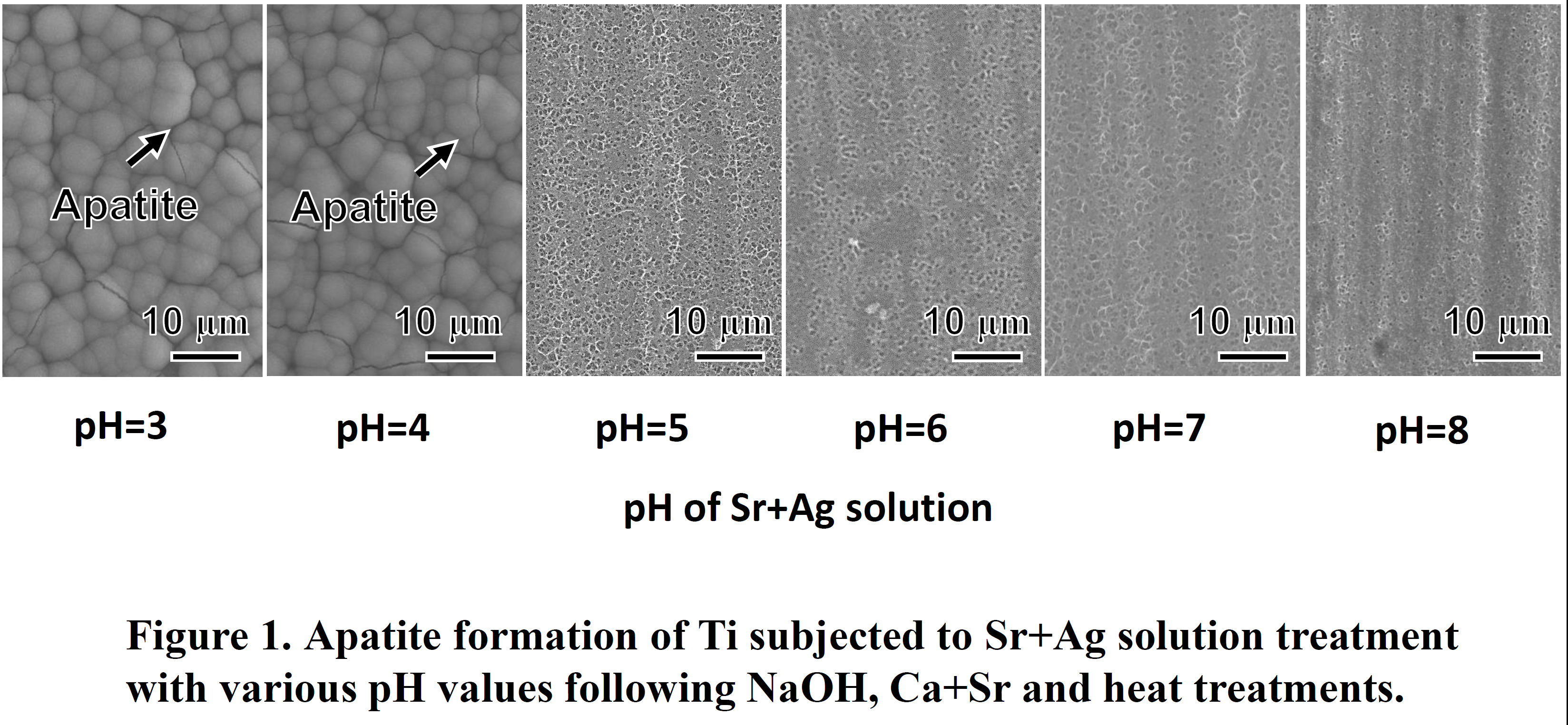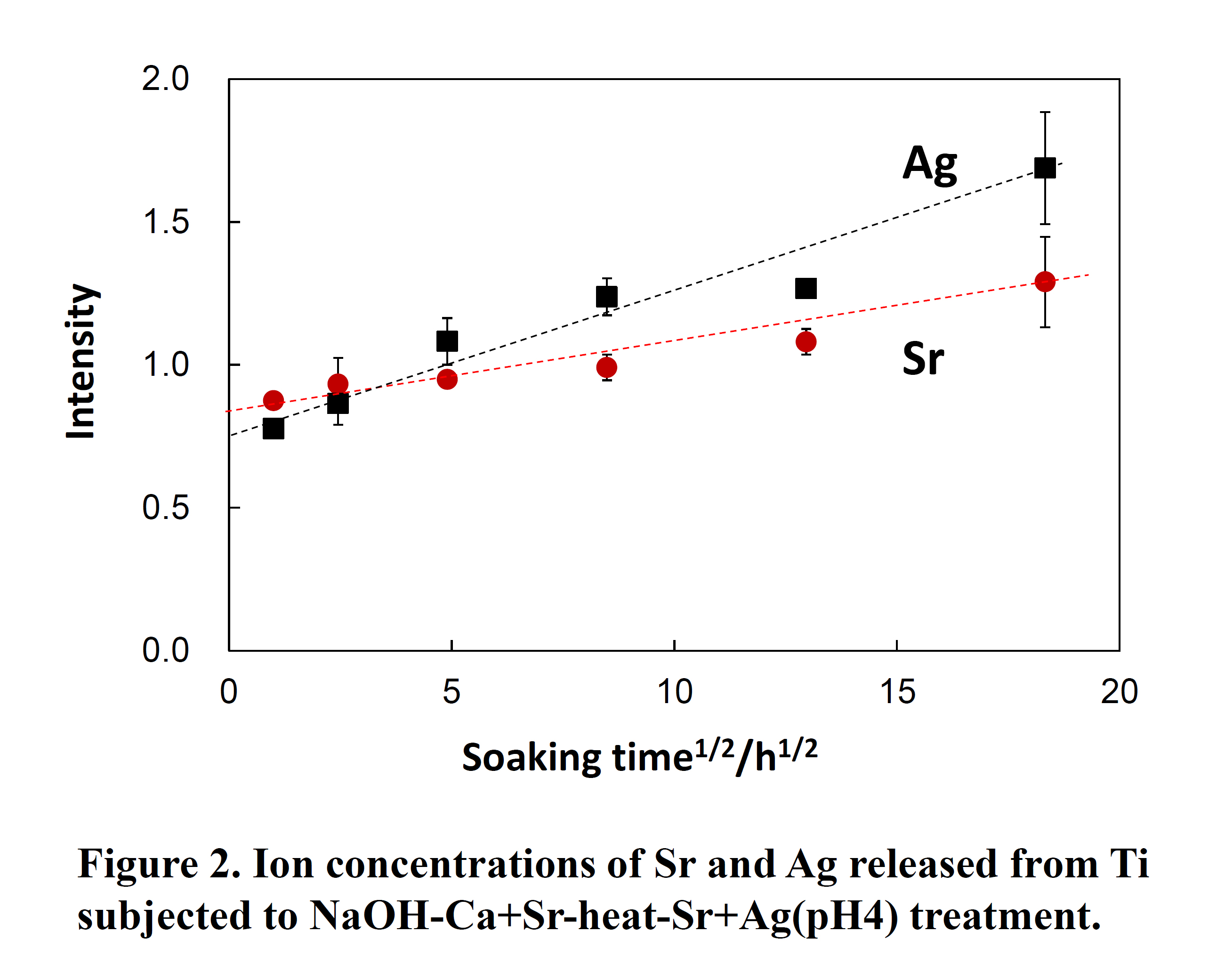Introduction: Titanium metal (Ti) is widely used in orthopedic and dental fields because of its good biocompatibility and high mechanical strength. However, it does not bond to living bone. Further, infection of the metal implant still remained a serious problem. The present authors have shown that Ti bonded to living bone through apatite formed on its surface in a living body, when a calcium titanate had been produced on Ti by NaOH, CaCl2, heat and water (Ca-heat) treatments[1]. Recently, it has been found that along with Ca, functional metal ions such as Sr, Mg, and Ag can be incorporated into the surface of Ti by modifying the Ca-heat treatment[2],[3].
In the present study, Sr and Ag ions, known for their promotional effect on bone formation and antibacterial activity, were incorporated into the surface of Ti at a time by solution and heat treatments. Apatite formation of the resultant product in a simulated body fluid (SBF) and release of Sr and Ag ions in fetal bovine serum (FBS) are discussed in terms of the surface structure.
Materials and Methods: Ti was soaked in 5 M NaOH aqueous solution, then subsequently in a mixed solution of 50 mM CaCl2 and 50 mM SrCl2 (Ca+Sr solution). They were heated at 600ºC, and then soaked in a mixed solution of 1 M Sr(NO3)2 and 1 mM AgNO3 (Sr+Ag solution) with various pH values from 3 to 8 adjusted by HNO3 and NH3(aq).
Surfaces of the samples were examined by SEM, EDX, XRD, Raman. Apatite formation on the samples were examined by soaking in SBF at 36.5 ºC[4]. Ion release of the samples were examined by measuring Sr and Ag ion concentrations in FBS released from the treated metals by ICP.
Results and Discussion: A surface layer composed of sodium hydrogen titanate was produced on Ti by the initial NaOH treatment. This was transformed to Sr-containing calcium hydrogen titanate with 2.3 % Ca and 1.3 % Sr by soaking in the Ca+Sr solution. Subsequent heat treatment produced Sr-containing calcium titanate, rutile and anatase on Ti. When the treated metal was soaked in the Sr+Ag solution with various pH values, 0.1 ~ 0.2 % Ag was additionally incorporated into the surface. A slight decrease of Ca and Sr in the surface layer were observed only when the solution with pH = 4 or 3 was used.
When the treated metals were soaked in SBF, only the Ti treated with Sr+Ag solution with pH = 4 or 3 formed apatite fully on its surface within 3 days, as shown in Fig.1. This might be due to the increased mobility of Ca ions in the surface layer induced by partial replacement of Ca ions with oxonium ions by the final solution treatment. Thus the Ti soaked in the solution with pH = 4 was subjected to the ion release test. As a result, it was found that the treated Ti slowly released 1.3 ppm of Sr and 1.7 ppm of Ag ions within 14 days in FBS, as shown in Fig.2.
Based on these results, it is expected that the treated Ti could promote bone formation by releasing Sr ions while prevent infection by releasing Ag ions. The newly grown might bond to Ti through the apatite that has been formed on Ti.


Conclusion: Ti with calcium titanate containing Sr and Ag able to release Sr and Ag ions was prepared by the chemical and heat treatments.
It is expected that the treated metal bonds to living bone in a short period of time and prevent infection, and might be useful for orthopedic and dental implants.
References:
[1] A. Fukuda, M. Takemoto, T. Saito, S. Fujibayashi, M. Neo, S. Yamaguchi, T. Kizuki, T. Matsushita, M. Niinomi, T. Kokubo and T. Nakamura, “Bone bonding bioactivity of Ti metal and Ti–Zr–Nb–Ta alloys with Ca ions incorporated on their surfaces by simple chemical and heat treatments,” Acta Biomater. Vol. 7, Mar 2011.
[2] S. Yamaguchi, S. Nath, T. Matsushita and T. Kokubo, “Controlled release of strontium ions from a bioactive Ti metal with a Ca-enriched surface layer,” Acta Biomater. Vol. 10, May 2014.
[3] T. Kizuki, T. Matsushita and T. Kokubo, “Antibacterial and bioactive calcium titanate layers formed on Ti metal and its alloys,” J Mater Sci: Mater Med. Vol. 25, Jul. 2014.
[4] T. Kokubo and H. Takadama, “How useful is SBF in predicting in vivo bone bioactivity?” Biomaterials. Vol. 27, May 2006.